MERCEDES-BENZ SPRINTER 2013 MY13 Operator’s Manual
Manufacturer: MERCEDES-BENZ, Model Year: 2013, Model line: SPRINTER, Model: MERCEDES-BENZ SPRINTER 2013Pages: 334, PDF Size: 3.88 MB
Page 21 of 334
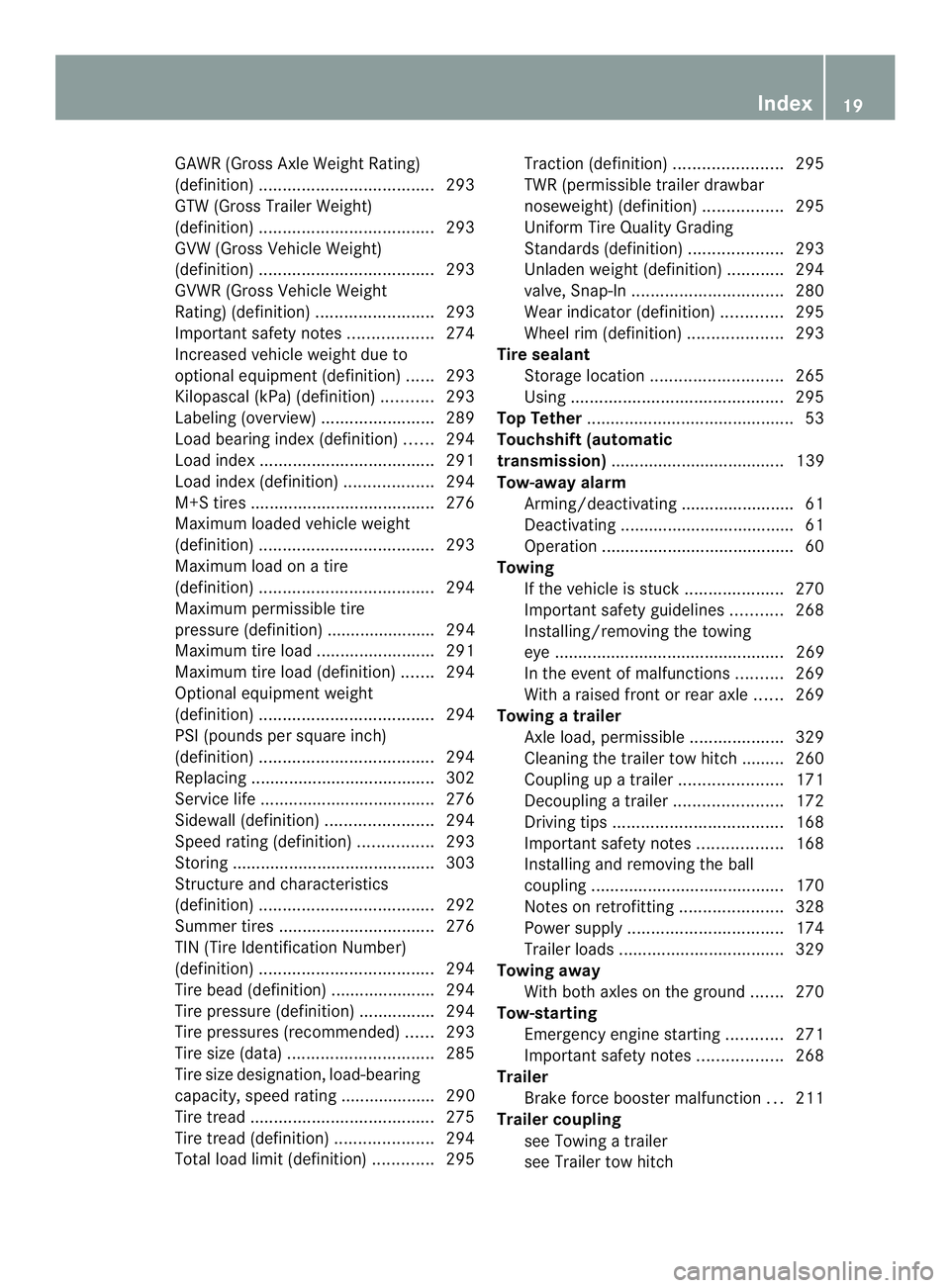
GAWR (Gross Axle Weigh
tRating)
(definition) ..................................... 293
GTW (Gross Trailer Weight)
(definition) ..................................... 293
GVW (Gross Vehicle Weight)
(definition) ..................................... 293
GVWR (Gross Vehicle Weight
Rating) (definition) .........................293
Important safety notes ..................274
Increased vehicle weight due to
optional equipment (definition) ......293
Kilopascal (kPa) (definition) ...........293
Labeling (overview )........................ 289
Load bearing index (definition) ......294
Load index ..................................... 291
Load index (definition) ...................294
M+S tires ....................................... 276
Maximum loaded vehicle weight
(definition) ..................................... 293
Maximum load on a tire
(definition) ..................................... 294
Maximum permissible tire
pressure (definition) ....................... 294
Maximum tire loa d......................... 291
Maximum tire load (definition) .......294
Optional equipment weight
(definition) ..................................... 294
PSI (pounds per square inch)
(definition) ..................................... 294
Replacing ....................................... 302
Service life ..................................... 276
Sidewall (definition) .......................294
Speed rating (definition) ................293
Storing ........................................... 303
Structure and characteristics
(definition) ..................................... 292
Summer tires ................................. 276
TIN (Tire Identification Number)
(definition) ..................................... 294
Tire bea d(definition) ...................... 294
Tire pressure (definition) ................294
Tire pressures (recommended )...... 293
Tire size (data) ............................... 285
Tire size designation, load-bearing
capacity, speed rating .................... 290
Tire tread ....................................... 275
Tire tread (definition) .....................294
Total load limit (definition) .............295 Traction (definition)
.......................295
TWR (permissible trailer drawbar
noseweight) (definition) .................295
Uniform Tire Quality Grading
Standard s(definition) .................... 293
Unladen weight (definition) ............294
valve, Snap-In ................................ 280
Wea rindicato r(definition) .............295
Whee lrim (definition ).................... 293
Tire sealant
Storage location ............................ 265
Using ............................................. 295
Top Tether ............................................ 53
Touchshift (automatic
transmission) ..................................... 139
Tow-away alarm Arming/deactivating ........................61
Deactivating .................................... .61
Operation ........................................ .60
Towing
If the vehicl eisstuck..................... 270
Important safety guidelines ...........268
Installing/removing the towing
eye. ................................................ 269
In the event of malfunction s.......... 269
With a raised front or rear axle ......269
Towing atrailer
Axle load ,permissible .................... 329
Cleaning the trailer tow hitch ......... 260
Coupling up atrailer ...................... 171
Decoupling atrailer ....................... 172
Driving tips .................................... 168
Important safety notes ..................168
Installing and removing the ball
coupling ......................................... 170
Notes on retrofitting ......................328
Power supply ................................. 174
Trailer loads ................................... 329
Towing away
With both axles on the ground .......270
Tow-starting
Emergency engine starting ............271
Important safety notes ..................268
Trailer
Brake force booster malfunction ...211
Trailer coupling
see Towing atrailer
see Trailer tow hitch Index
19
Page 22 of 334
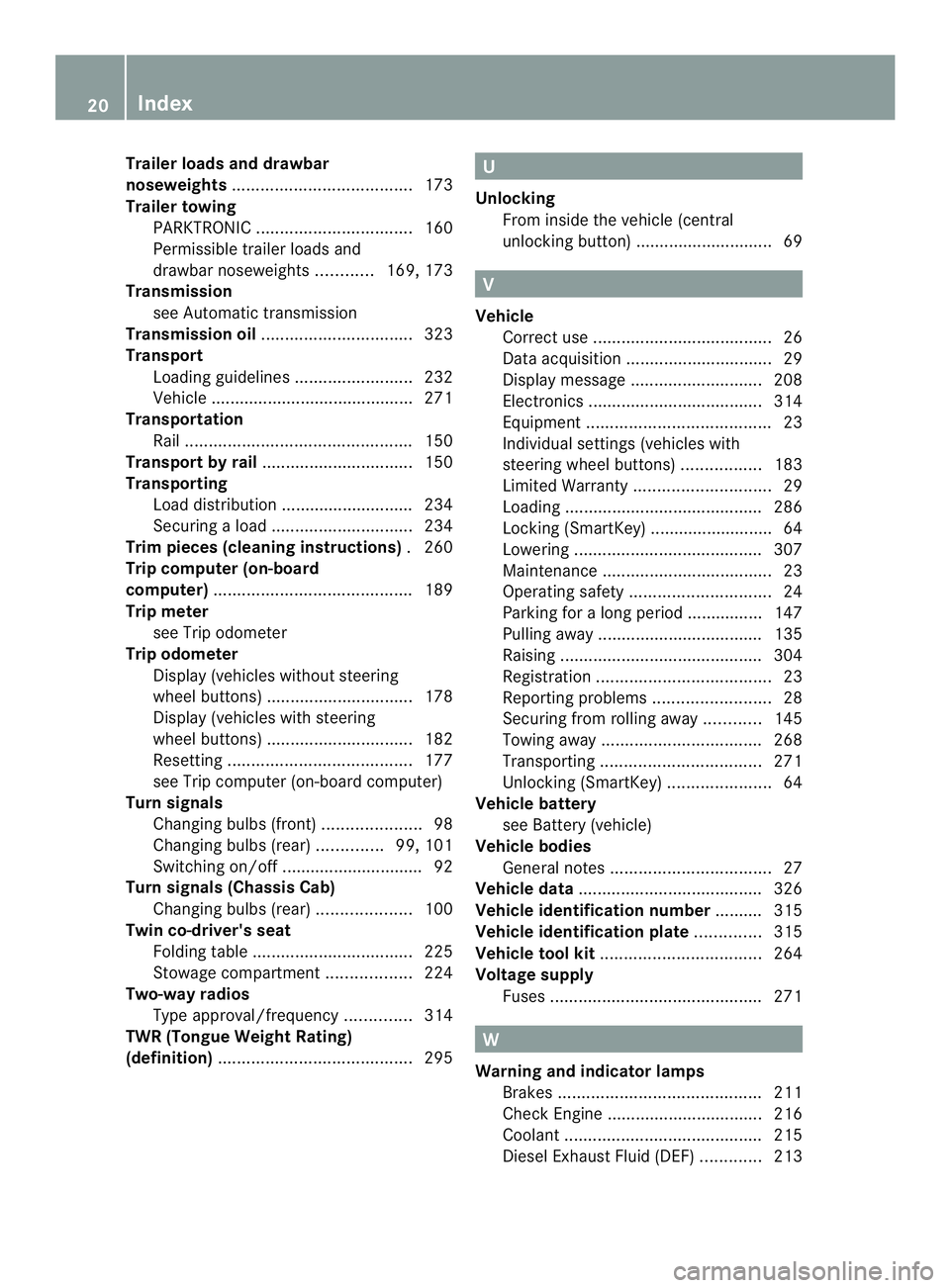
Trailer loads and drawbar
noseweights
...................................... 173
Trailer towing PARKTRONI C................................. 160
Permissible trailer loads and
drawba rnoseweights ............169, 173
Transmission
see Automatic transmission
Transmission oil ................................ 323
Transport Loading guidelines .........................232
Vehicle .......................................... .271
Transportation
Rail ................................................ 150
Transport by rail ................................ 150
Transporting Load distribution ............................ 234
Securing aload .............................. 234
Trim pieces (cleaning instructions) .260
Trip computer (on-board
computer) .......................................... 189
Trip meter see Trip odometer
Trip odometer
Display (vehicles without steering
wheel buttons) ............................... 178
Display (vehicles with steering
wheel buttons) ............................... 182
Resetting ....................................... 177
see Trip computer (on-board computer)
Turn signals
Changing bulbs (front) .....................98
Changing bulbs (rear) ..............99, 101
Switching on/off .............................. 92
Turn signals (Chassis Cab)
Changing bulbs (rear) ....................100
Twin co-driver's seat
Folding tabl e.................................. 225
Stowag ecompartmen t.................. 224
Two-way radios
Type approval/frequency ..............314
TWR (Tongue Weight Rating)
(definition) ......................................... 295 U
Unlocking From inside the vehicle (central
unlocking button) ............................. 69 V
Vehicle Correct use ...................................... 26
Data acquisition ............................... 29
Display message ............................ 208
Electronics ..................................... 314
Equipment ....................................... 23
Individual settings (vehicles with
steering wheel buttons) .................183
Limited Warranty ............................. 29
Loading .......................................... 286
Locking (SmartKey) .......................... 64
Lowering ........................................ 307
Maintenance .................................... 23
Operating safety .............................. 24
Parking for a long period ................ 147
Pulling away ................................... 135
Raising ........................................... 304
Registration ..................................... 23
Reporting problems .........................28
Securing from rolling away ............145
Towing away .................................. 268
Transporting .................................. 271
Unlocking (SmartKey) ......................64
Vehicle battery
see Battery (vehicle)
Vehicle bodies
General notes .................................. 27
Vehicle data ....................................... 326
Vehicle identification number .......... 315
Vehicle identification plate ..............315
Vehicle tool kit .................................. 264
Voltage supply Fuse s............................................. 271 W
Warning and indicator lamps Brakes ........................................... 211
Check Engine ................................. 216
Coolant .......................................... 215
Diesel Exhaus tFluid (DEF) .............213 20
Index
Page 23 of 334
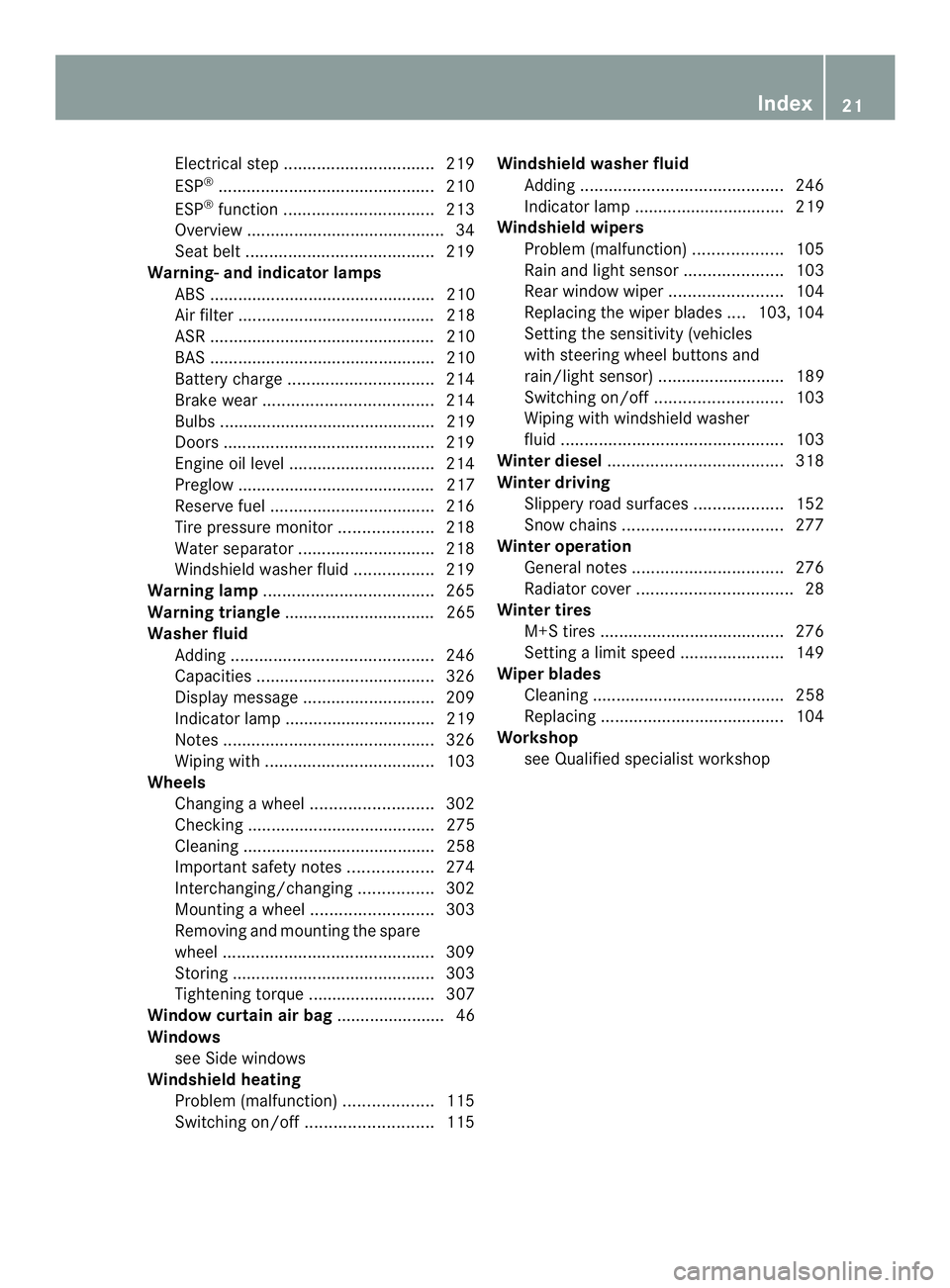
Electrical ste
p................................ 219
ESP ®
.............................................. 210
ESP ®
function ................................ 213
Overview .......................................... 34
Seat bel t........................................ 219
Warning- and indicator lamps
ABS ................................................ 210
Air filter .......................................... 218
ASR ................................................ 210
BAS ................................................ 210
Battery charg e............................... 214
Brake wea r.................................... 214
Bulbs .............................................. 219
Doors ............................................. 219
Engine oil leve l............................... 214
Preglow .......................................... 217
Reserve fuel ................................... 216
Tire pressure monitor ....................218
Water separator ............................. 218
Windshield washer fluid .................219
Warning lamp .................................... 265
Warning triangle ................................ 265
Washer fluid Adding ........................................... 246
Capacities ...................................... 326
Display message ............................ 209
Indicator lamp ................................ 219
Notes ............................................. 326
Wiping with .................................... 103
Wheels
Changing awheel .......................... 302
Checking ........................................ 275
Cleaning ......................................... 258
Important safety notes ..................274
Interchanging/changing ................302
Mounting awheel .......................... 303
Removing and mounting the spare
wheel ............................................. 309
Storing ........................................... 303
Tightening torque ........................... 307
Window curtain air bag ....................... 46
Windows see Side windows
Windshiel dheating
Problem (malfunction) ...................115
Switching on/off ........................... 115Windshiel
dwasher fluid
Adding ........................................... 246
Indicator lamp ................................ 219
Windshiel dwipers
Problem (malfunction) ...................105
Rain and light sensor .....................103
Rea rwindow wiper ........................ 104
Replacing the wiper blades ....103, 104
Setting the sensitivity (vehicles
with steering wheel buttons and
rain/light sensor) ........................... 189
Switching on/off ........................... 103
Wiping with windshield washer
fluid ............................................... 103
Winte rdiesel ..................................... 318
Winte rdriving
Slippery roa dsurface s................... 152
Snow chains .................................. 277
Winter operation
General notes ................................ 276
Radiator cover ................................. 28
Winter tires
M+S tires ....................................... 276
Setting alimit speed ...................... 149
Wiper blades
Cleaning ......................................... 258
Replacing ....................................... 104
Workshop
see Qualified specialist workshop Index
21
Page 24 of 334
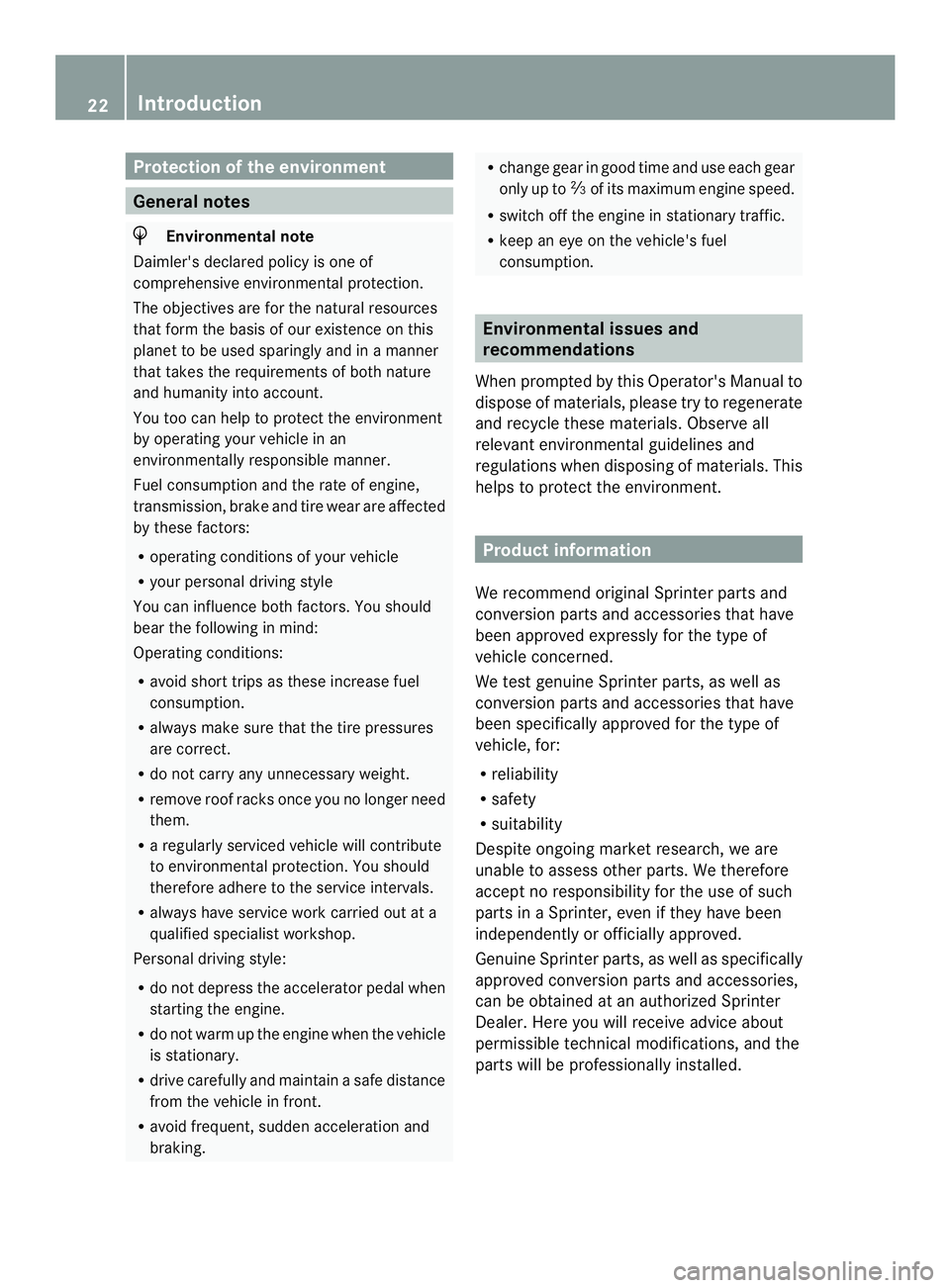
Protection of the environment
General notes
H
Environmental note
Daimler's declared policy is one of
comprehensive environmental protection.
The objectives are for the natural resources
that form the basis of our existence on this
planet to be used sparingly and in a manner
that takes the requirements of both nature
and humanity into account.
You too can help to protect the environment
by operating your vehicle in an
environmentally responsible manner.
Fuel consumption and the rate of engine,
transmission, brake and tire wear are affected
by these factors:
R operating conditions of your vehicle
R your personal driving style
You can influence both factors. You should
bear the following in mind:
Operating conditions:
R avoid short trips as these increase fuel
consumption.
R always make sure that the tire pressures
are correct.
R do not carry any unnecessary weight.
R remove roof racks once you no longer need
them.
R a regularly serviced vehicle will contribute
to environmental protection. You should
therefore adhere to the service intervals.
R always have service work carried out at a
qualified specialist workshop.
Personal driving style:
R do not depress the accelerator pedal when
starting the engine.
R do not warm up the engine when the vehicle
is stationary.
R drive carefully and maintain a safe distance
from the vehicle in front.
R avoid frequent, sudden acceleration and
braking. R
change gear in good time and use each gear
only up to 0004of its maximum engine speed.
R switch off the engine in stationary traffic.
R keep an eye on the vehicle's fuel
consumption. Environmental issues and
recommendations
When prompted by this Operator's Manual to
dispose of materials, please try to regenerate
and recycle these materials. Observe all
relevant environmental guidelines and
regulations when disposing of materials. This
helps to protect the environment. Product information
We recommend original Sprinter parts and
conversion parts and accessories that have
been approved expressly for the type of
vehicle concerned.
We test genuine Sprinter parts, as well as
conversion parts and accessories that have
been specifically approved for the type of
vehicle, for:
R reliability
R safety
R suitability
Despite ongoing market research, we are
unable to assess other parts. We therefore
accept no responsibility for the use of such
parts in a Sprinter, even if they have been
independently or officially approved.
Genuine Sprinter parts, as well as specifically
approved conversion parts and accessories,
can be obtained at an authorized Sprinter
Dealer. Here you will receive advice about
permissible technical modifications, and the
parts will be professionally installed. 22
Introduction
Page 25 of 334
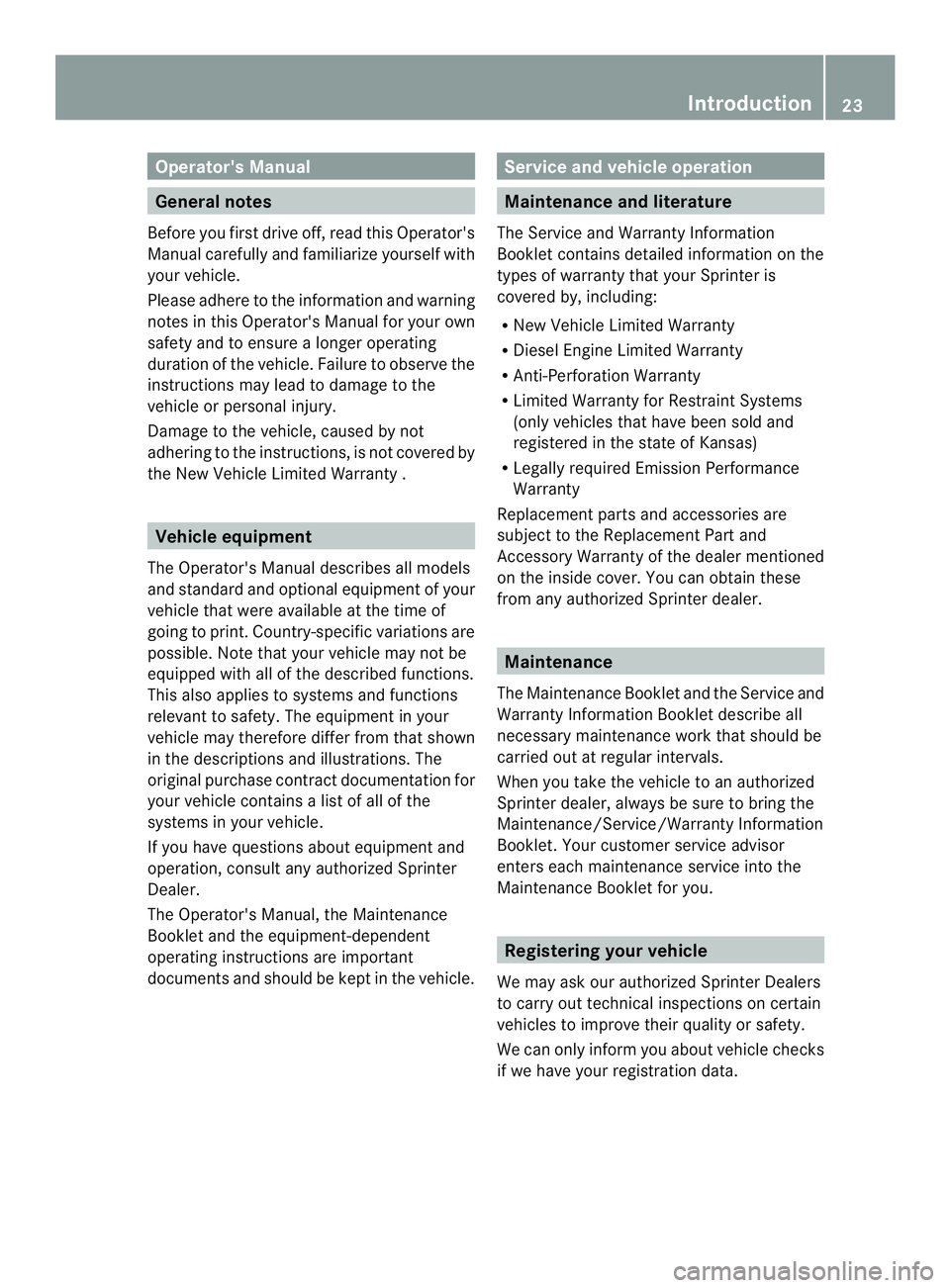
Operator's Manual
General notes
Before you first drive off, read this Operator's
Manual carefully and familiarize yourself with
your vehicle.
Please adhere to the information and warning
notes in this Operator's Manual for your own
safety and to ensure a longer operating
duration of the vehicle. Failure to observe the
instructions may lead to damage to the
vehicle or personal injury.
Damage to the vehicle, caused by not
adhering to the instructions, is not covered by
the New Vehicle Limited Warranty . Vehicle equipment
The Operator's Manual describes all models
and standard and optional equipment of your
vehicle that were available at the time of
going to print .Country-specific variations are
possible. Note that your vehicle may not be
equipped with all of the described functions.
This also applies to systems and functions
relevant to safety. The equipment in your
vehicle may therefore differ from that shown
in the descriptions and illustrations. The
original purchase contract documentation for
your vehicle contains a list of all of the
systems in your vehicle.
If you have questions about equipment and
operation, consult any authorized Sprinter
Dealer.
The Operator's Manual, the Maintenance
Booklet and the equipment-dependent
operating instructions are important
documents and should be kept in the vehicle. Service and vehicle operation
Maintenance and literature
The Service and Warranty Information
Booklet contains detailed information on the
types of warranty that your Sprinter is
covered by, including:
R New Vehicle Limited Warranty
R Diesel Engine Limited Warranty
R Anti-Perforation Warranty
R Limited Warranty for Restraint Systems
(only vehicles that have been sold and
registered in the state of Kansas)
R Legally required Emission Performance
Warranty
Replacement parts and accessories are
subject to the Replacement Part and
Accessory Warranty of the dealer mentioned
on the inside cover. You can obtain these
from any authorized Sprinter dealer. Maintenance
The Maintenance Booklet and the Service and
Warranty Information Booklet describe all
necessary maintenance work that should be
carried out at regular intervals.
When you take the vehicle to an authorized
Sprinter dealer, always be sure to bring the
Maintenance/Service/Warranty Information
Booklet .Your customer service advisor
enters each maintenance service into the
Maintenance Booklet for you. Registering your vehicle
We may ask our authorized Sprinter Dealers
to carry out technical inspections on certain
vehicles to improve their quality or safety.
We can only inform you about vehicle checks
if we have your registration data. Introduction
23 Z
Page 26 of 334
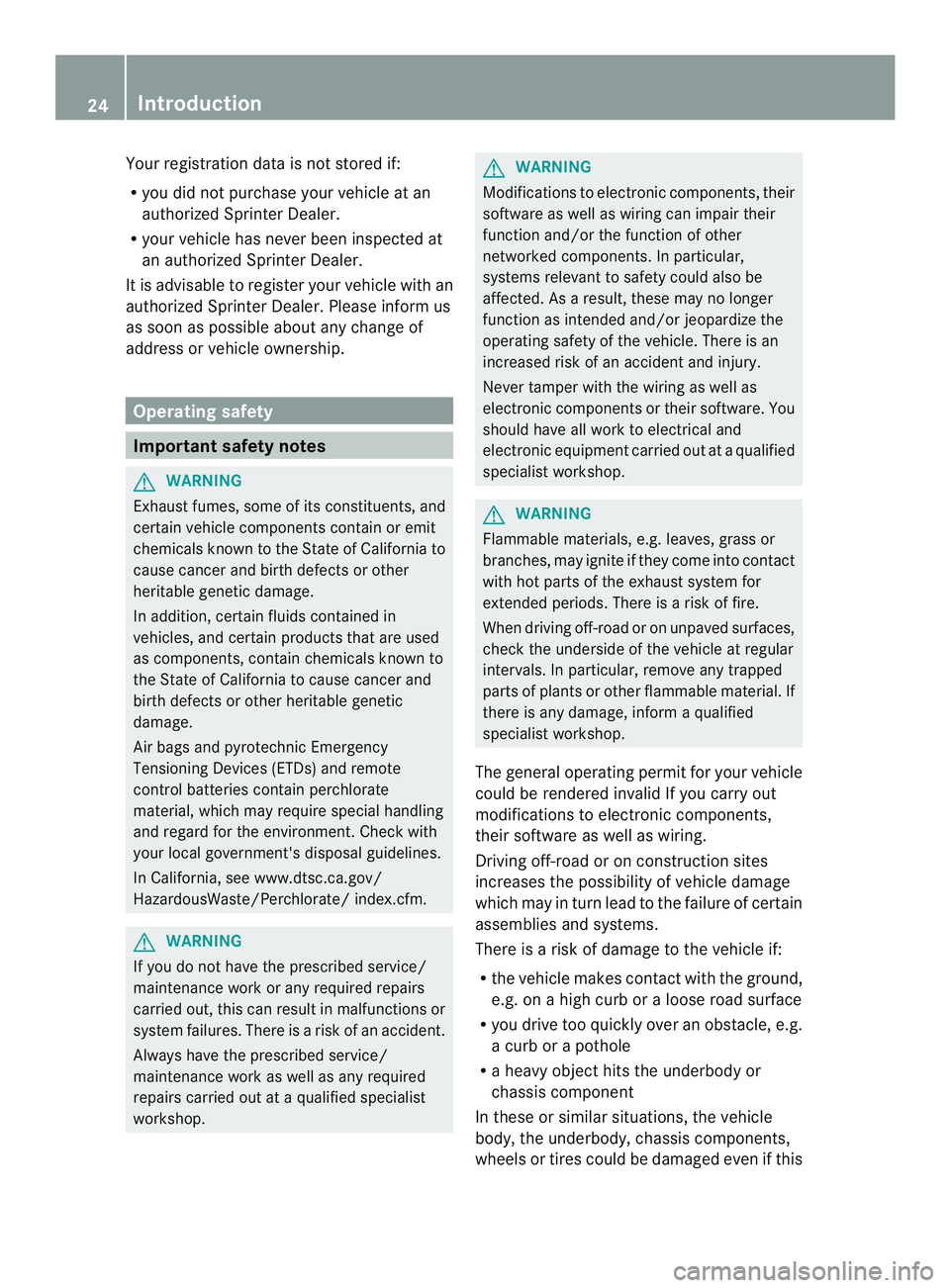
Your registratio
ndata is no tstored if:
R you did not purchase your vehicle at an
authorized Sprinte rDealer.
R your vehicle has never been inspected at
an authorized Sprinter Dealer.
It is advisable to register your vehicle with an
authorized Sprinter Dealer. Please infor mus
as soon as possible about any change of
address or vehicle ownership. Operating safety
Important safety notes
G
WARNING
Exhaust fumes, some of its constituents, and
certain vehicle components contain or emit
chemicals known to the State of California to
cause cancer and birth defects or other
heritable genetic damage.
In addition, certain fluid scontained in
vehicles, and certain products that are used
as components, contain chemicals known to
the State of California to cause cancer and
birth defects or other heritable genetic
damage.
Air bags and pyrotechnic Emergency
Tensioning Devices (ETDs) and remote
control batteries contain perchlorate
material, which may require special handling
and regard for the environment. Check with
your local government's disposal guidelines.
In California, see www.dtsc.ca.gov/
HazardousWaste/Perchlorate/ index.cfm. G
WARNING
If you do not have the prescribed service/
maintenance work or any required repairs
carried out, this can result in malfunctions or
system failures. There is a risk of an accident.
Always have the prescribed service/
maintenance work as well as any required
repairs carried out at a qualified specialist
workshop. G
WARNING
Modifications to electronic components, their
software as well as wiring can impair their
function and/or the function of other
networked components. In particular,
systems relevant to safety could also be
affected. As a result, these may no longer
function as intended and/or jeopardize the
operating safety of the vehicle. There is an
increased risk of an accident and injury.
Never tamper with the wiring as well as
electronic components or their software. You
should have all work to electrical and
electronic equipment carried out at a qualified
specialist workshop. G
WARNING
Flammable materials, e.g. leaves, grass or
branches, may ignite if they come into contact
with hot parts of the exhaust system for
extended periods. There is arisk of fire.
When driving off-road or on unpaved surfaces,
chec kthe underside of the vehicle at regular
intervals. In particular, remove any trapped
parts of plants or other flammable material. If
there is any damage, inform a qualified
specialist workshop.
The general operating permit for your vehicle
could be rendered invalid If you carry out
modifications to electronic components,
their software as well as wiring.
Driving off-road or on construction sites
increases the possibility of vehicle damage
which may in turn lead to the failure of certain
assemblies and systems.
There is a risk of damage to the vehicle if:
R the vehicle makes contact with the ground,
e.g. on a high curb or a loose road surface
R you drive too quickly over an obstacle, e.g.
a curb or a pothole
R a heavy object hits the underbody or
chassis component
In these or similar situations, the vehicle
body, the underbody, chassis components,
wheels or tires could be damaged even if this 24
Introduction
Page 27 of 334
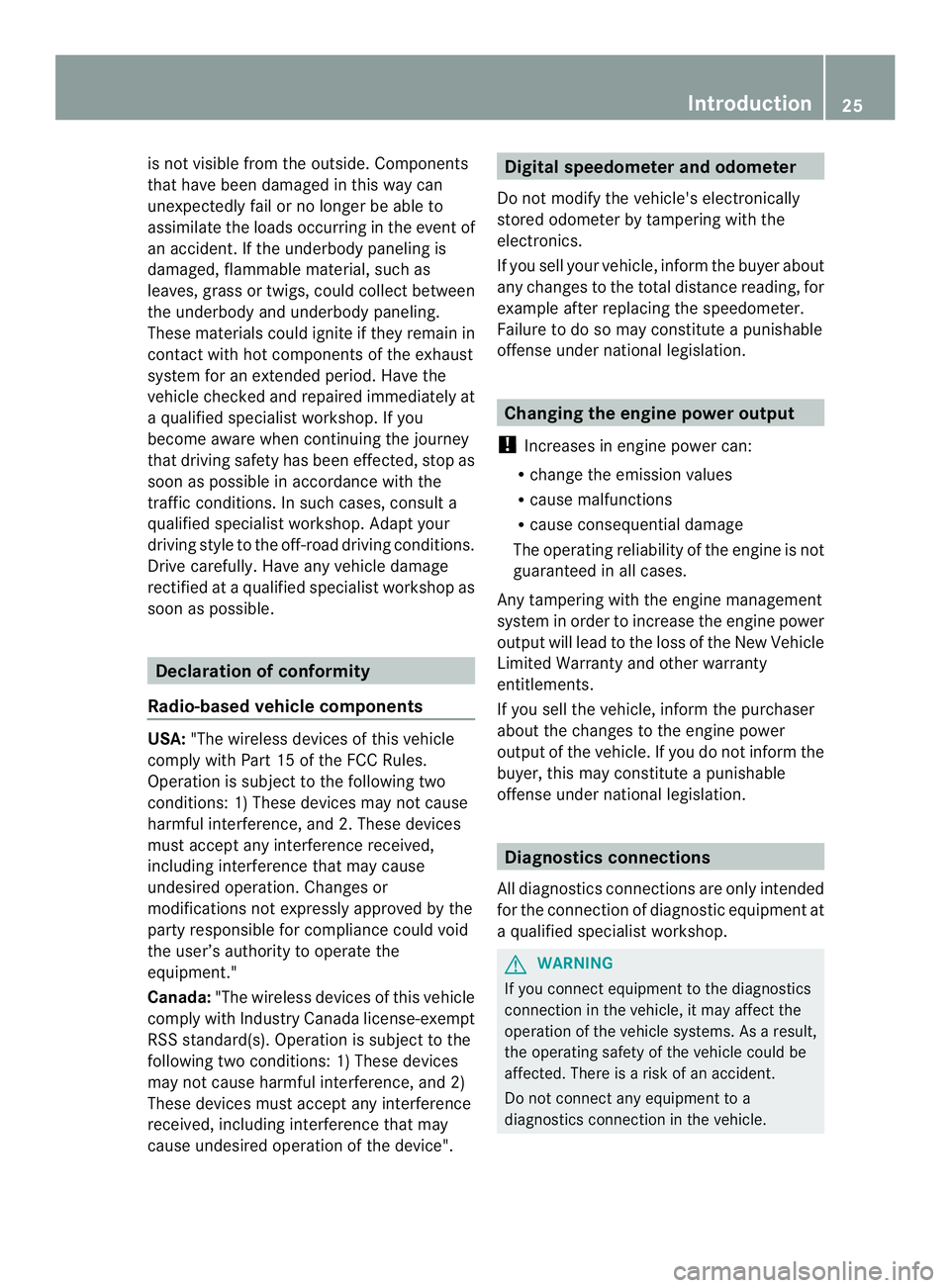
is not visible fro
mthe outside. Components
that have been damaged in this way can
unexpectedly fail or no longer be able to
assimilate the loads occurring in the event of
an accident. If the underbody paneling is
damaged, flammable material, such as
leaves, grass or twigs, could collect between
the underbody and underbody paneling.
These materials could ignite if they remain in
contact with hot components of the exhaust
system for an extended period. Have the
vehicle checked and repaired immediately at
a qualified specialist workshop. If you
become aware when continuing the journey
that driving safety has been effected, stop as
soon as possible in accordance with the
traffic conditions. In such cases, consult a
qualified specialist workshop. Adapt your
driving style to the off-road driving conditions.
Drive carefully. Have any vehicle damage
rectified at a qualified specialist workshop as
soon as possible. Declaration of conformity
Radio-based vehicle components USA:
"The wireless devices of this vehicle
comply with Part 15 of the FCC Rules.
Operation is subject to the following two
conditions: 1) These devices may not cause
harmful interference, and 2. These devices
must accept any interference received,
including interference that may cause
undesired operation. Changes or
modifications not expressly approved by the
party responsible for compliance could void
the user’s authority to operate the
equipment."
Canada: "The wireless devices of this vehicle
comply with Industry Canada license-exempt
RSS standard(s). Operation is subject to the
following two conditions: 1) These devices
may not cause harmful interference, and 2)
These devices must accept any interference
received, including interference that may
cause undesired operation of the device". Digital speedometer and odometer
Do not modify the vehicle's electronically
stored odometer by tampering with the
electronics.
If you sell your vehicle, inform the buyera bout
any changes to the total distance reading, for
example after replacing the speedometer.
Failure to do so may constitute a punishable
offense under national legislation. Changing the engine power output
! Increases in engine power can:
R change the emission values
R cause malfunctions
R cause consequential damage
The operating reliability of the engine is not
guaranteed in all cases.
Any tampering with the engine management
system in order to increase the engine power
output will lead to the loss of the New Vehicle
Limited Warranty and other warranty
entitlements.
If you sell the vehicle, infor mthe purchaser
about the changes to the engine power
output of the vehicle. If you do not inform the
buyer, this may constitute a punishable
offense under national legislation. Diagnostics connections
All diagnostics connections are only intended
for the connection of diagnostic equipment at
a qualified specialist workshop. G
WARNING
If you connect equipment to the diagnostics
connection in the vehicle, it may affect the
operation of the vehicle systems. As a result,
the operating safety of the vehicle could be
affected. There is a risk of an accident.
Do not connect any equipment to a
diagnostics connection in the vehicle. Introduction
25 Z
Page 28 of 334
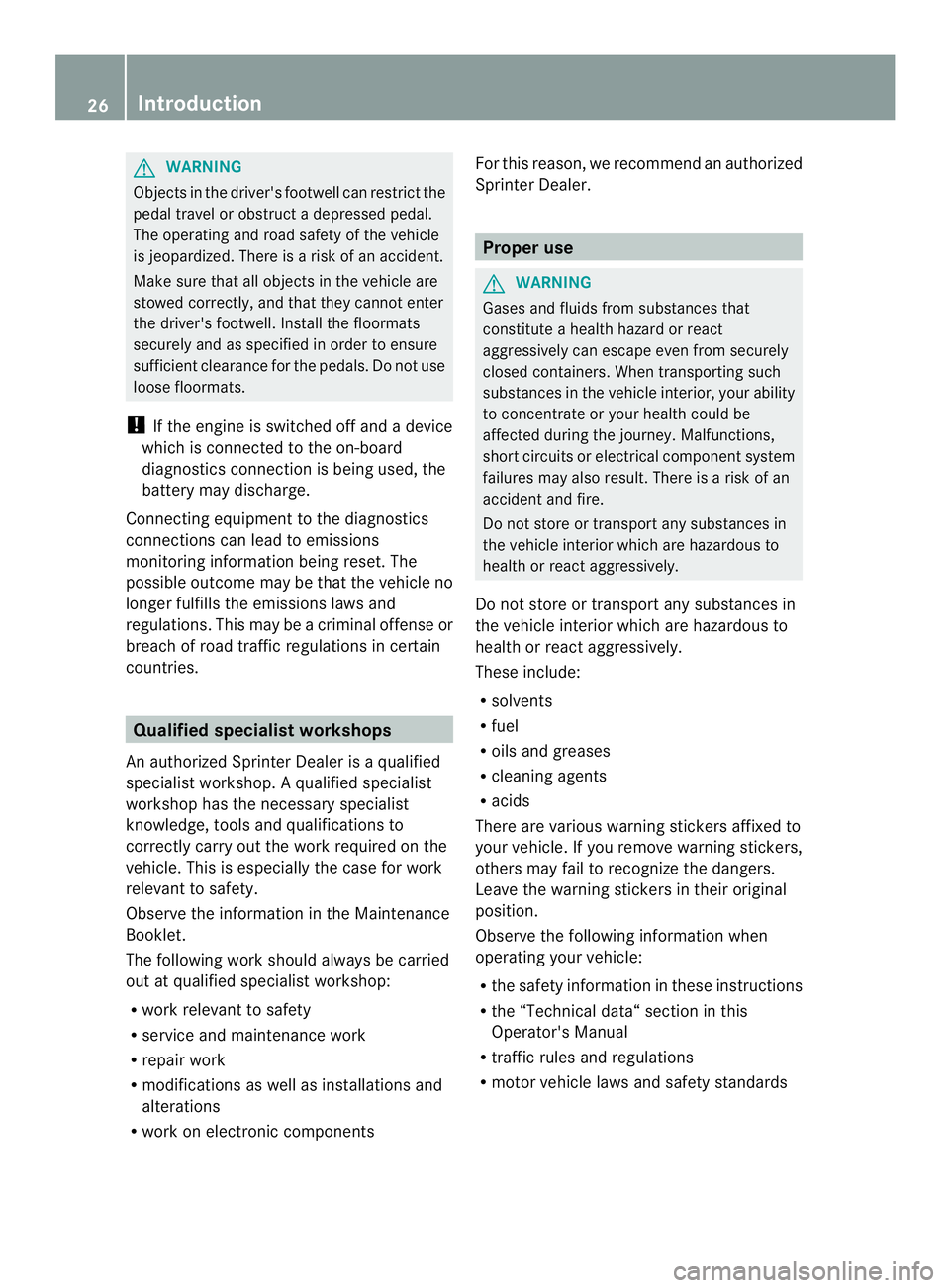
G
WARNING
Objects in the driver's footwell can restrict the
pedal travel or obstruct adepressed pedal.
The operating and road safety of the vehicle
is jeopardized. There is a risk of an accident.
Make sure that all objects in the vehicle are
stowed correctly, and that they cannot enter
the driver's footwell. Install the floormats
securely and as specified in order to ensure
sufficien tclearance for the pedals. Do not use
loose floormats.
! If the engine is switched off and a device
which is connected to the on-board
diagnostics connection is being used, the
battery may discharge.
Connecting equipmen tto the diagnostics
connections can lead to emissions
monitoring information being reset. The
possible outcome may be that the vehicle no
longer fulfills the emissions laws and
regulations. This may be acriminal offense or
breach of road traffic regulations in certain
countries. Qualified specialist workshops
An authorized Sprinter Deale ris a qualified
specialist workshop. Aqualified specialist
workshop has the necessary specialist
knowledge, tools and qualifications to
correctly carry out the work required on the
vehicle. This is especially the case for work
relevan tto safety.
Observe the information in the Maintenance
Booklet.
The following work should always be carried
out at qualified specialist workshop:
R work relevant to safety
R service and maintenance work
R repair work
R modifications as well as installations and
alterations
R work on electronic components For this reason, we recommend an authorized
Sprinter Dealer. Proper use
G
WARNING
Gases and fluids from substances that
constitute a health hazard or react
aggressively can escape even from securely
closed containers. When transporting such
substances in the vehicle interior, your ability
to concentrate or your health could be
affected during the journey. Malfunctions,
short circuits or electrical componen tsystem
failures may also result .There is a risk of an
accident and fire.
Do not store or transport any substances in
the vehicle interior which are hazardous to
health or react aggressively.
Do not store or transport any substances in
the vehicle interior which are hazardous to
health or react aggressively.
These include:
R solvents
R fuel
R oils and greases
R cleaning agents
R acids
There are various warning stickers affixed to
your vehicle. If you remove warning stickers,
others may fail to recognize the dangers.
Leave the warning stickers in their original
position.
Observe the following information when
operating your vehicle:
R the safety information in these instructions
R the “Technical data“ section in this
Operator's Manual
R traffic rules and regulations
R motor vehicle laws and safety standards 26
Introduction
Page 29 of 334
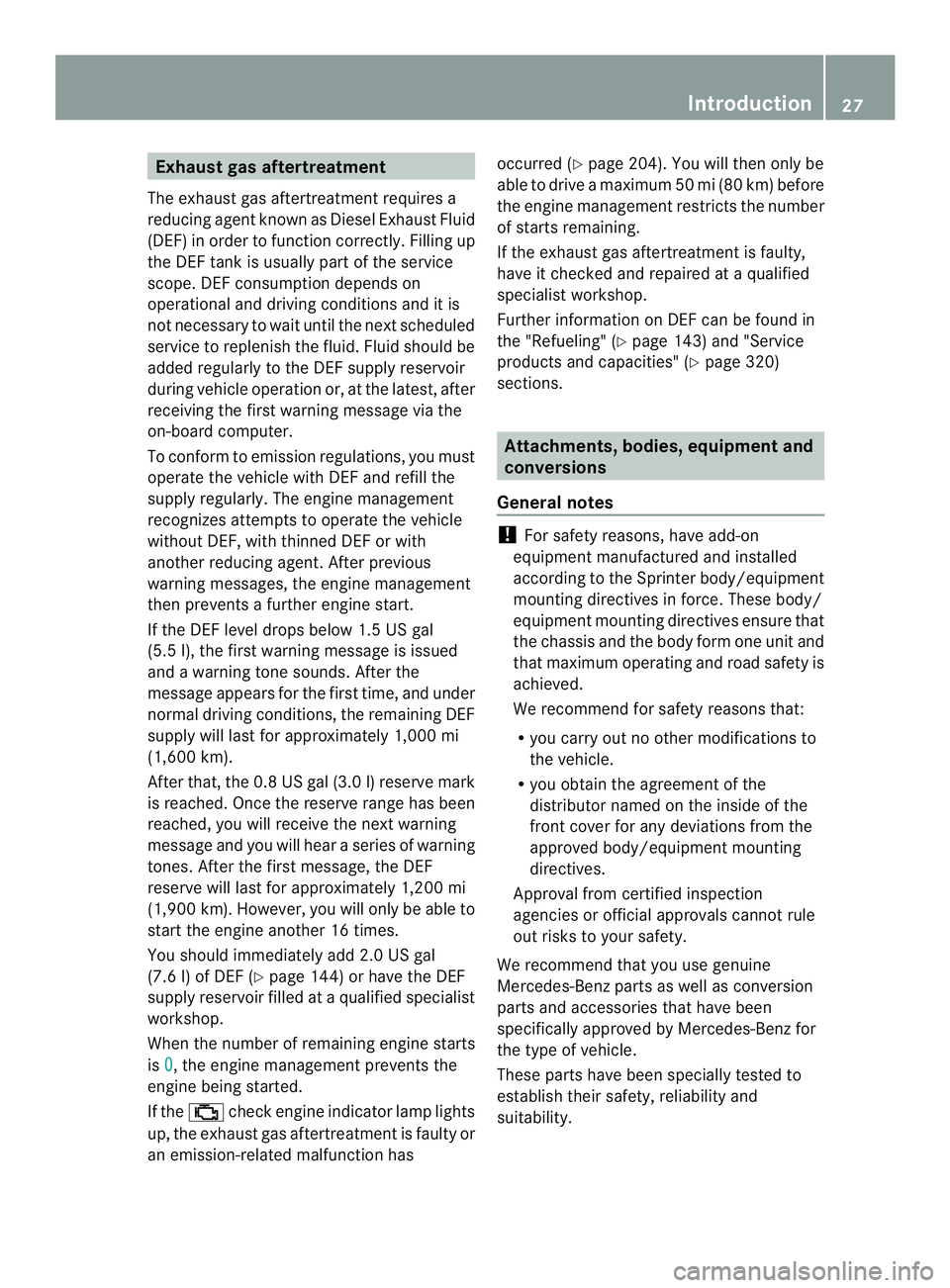
Exhaust gas aftertreatment
The exhaust gas aftertreatmen trequires a
reducing agent known as Diesel Exhaust Fluid
(DEF) in order to function correctly. Filling up
the DEF tank is usually part of the service
scope. DEFc onsumption depends on
operational and driving conditions and it is
not necessary to wait until the next scheduled
service to replenish the fluid. Fluid should be
added regularly to the DEFs upply reservoir
during vehicle operation or, at the latest, after
receiving the first warning message via the
on-board computer.
To conform to emission regulations, you must
operate the vehicle with DE Fand refill the
supply regularly .The engine management
recognizes attempts to operate the vehicle
without DEF, with thinned DEF or with
another reducing agent. After previous
warning messages, the engine management
then prevents a further engine start.
If the DEF level drops below 1.5 US gal
(5.5 l), the first warning message is issued
and a warning tone sounds. After the
message appears for the first time, and under
normal driving conditions, the remaining DEF
supply will last for approximately 1,000 mi
(1,600 km).
After that, the 0.8 US gal (3.0 l)reserve mark
is reached. Once the reserve range has been
reached, you will receive the next warning
message and you will hearas eries of warning
tones. After the first message, the DEF
reserve will last for approximately 1,200 mi
(1,900 km). However, you will only be able to
start the engine another 16 times.
You should immediately add 2.0 US gal
(7.6 l) of DEF (Y page 144) or have the DEF
supply reservoir filled at a qualified specialist
workshop.
When the number of remaining engine starts
is 0 , the engine management prevents the
engine being started.
If the 0018 checkengine indicator lamp lights
up, the exhaust gas aftertreatment is faulty or
an emission-related malfunctio nhas occurred (Y
page 204). You will then only be
able to drive a maximum 50 mi (80 km) before
the engine managemen trestricts the number
of starts remaining.
If the exhaust gas aftertreatment is faulty,
have it checked and repaired at a qualified
specialist workshop.
Further information on DEF can be found in
the "Refueling" ( Ypage 143) and "Service
products and capacities" (Y page 320)
sections. Attachments, bodies, equipment and
conversions
General notes !
For safety reasons, have add-on
equipment manufactured and installed
according to the Sprinter body/equipment
mounting directives in force. These body/
equipment mounting directives ensure that
the chassis and the body form one unit and
that maximum operating and road safety is
achieved.
We recommend for safety reasons that:
R you carry out no other modifications to
the vehicle.
R you obtain the agreement of the
distributor named on the inside of the
front cover for any deviations from the
approved body/equipment mounting
directives.
Approval from certified inspection
agencies or official approvals cannot rule
out risks to your safety.
We recommend that you use genuine
Mercedes-Benzp arts as well as conversion
parts and accessories that have been
specifically approved by Mercedes-Ben zfor
the type of vehicle.
These parts have been specially tested to
establish their safety, reliability and
suitability. Introduction
27 Z
Page 30 of 334
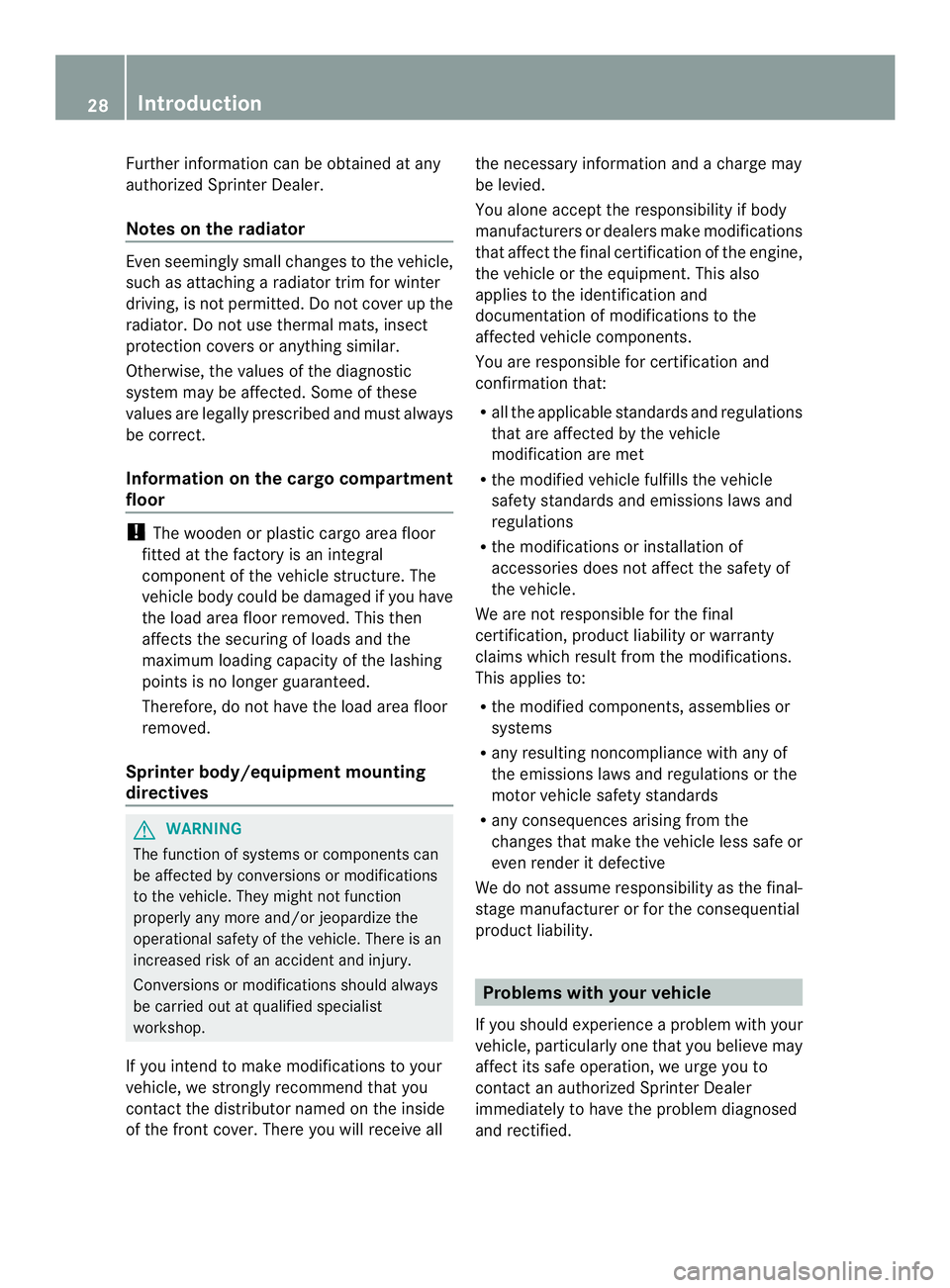
Further information can be obtained at any
authorized Sprinter Dealer.
Notes on the radiator
Even seemingly small changes to the vehicle,
such as attaching a radiator trim for winter
driving, is not permitted
.Do not cover up the
radiator. Do not use thermal mats, insect
protection covers or anything similar.
Otherwise, the values of the diagnostic
system may be affected. Some of these
values are legally prescribed and must always
be correct.
Information on the cargo compartment
floor !
The wooden or plastic cargo area floor
fitted at the factory is an integral
component of the vehicle structure. The
vehicle body could be damaged if you have
the load area floor removed. This then
affects the securing of loads and the
maximum loading capacity of the lashing
points is no longer guaranteed.
Therefore, do not have the load area floor
removed.
Sprinter body/equipment mounting
directives G
WARNING
The function of systems or components can
be affected by conversions or modifications
to the vehicle. They might not function
properly any more and/or jeopardize the
operational safety of the vehicle. There is an
increased risk of an accident and injury.
Conversions or modifications should always
be carried out at qualified specialist
workshop.
If you intend to make modifications to your
vehicle, we strongly recommend that you
contact the distributor named on the inside
of the front cover. There you will receive all the necessary information and a charge may
be levied.
You alone accept the responsibility if body
manufacturers or dealers make modifications
that affect the final certification of the engine,
the vehicle or the equipment. This also
applies to the identification and
documentation of modifications to the
affected vehicle components.
You are responsible for certification and
confirmation that:
R all the applicable standards and regulations
that are affected by the vehicle
modification are met
R the modified vehicle fulfills the vehicle
safety standards and emissions laws and
regulations
R the modifications or installation of
accessories does not affect the safety of
the vehicle.
We are not responsible for the final
certification, product liability or warranty
claims which result from the modifications.
This applies to:
R the modified components, assemblies or
systems
R any resulting noncompliance with any of
the emissions laws and regulations or the
motor vehicle safety standards
R any consequences arising from the
changes that make the vehicle less safe or
even render it defective
We do not assume responsibility as the final-
stage manufacturer or for the consequential
product liability. Problems with your vehicle
If you should experience aproble mwith your
vehicle, particularly one that you believe may
affec tits safe operation, we urge you to
contact an authorized Sprinter Dealer
immediately to have the problem diagnosed
and rectified. 28
Introduction